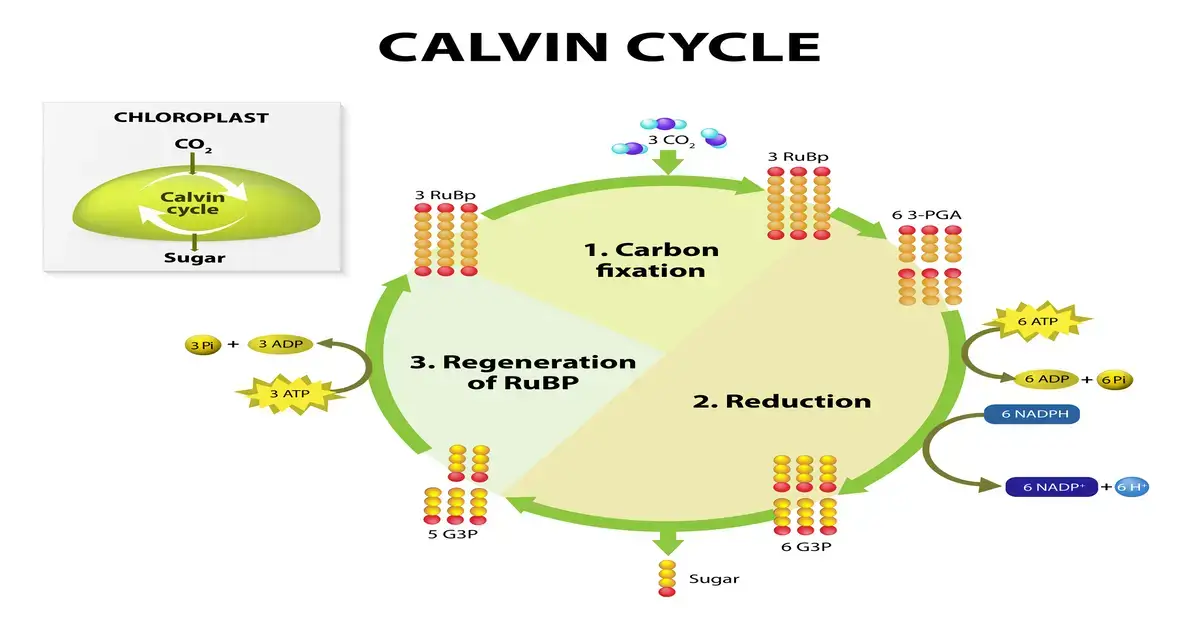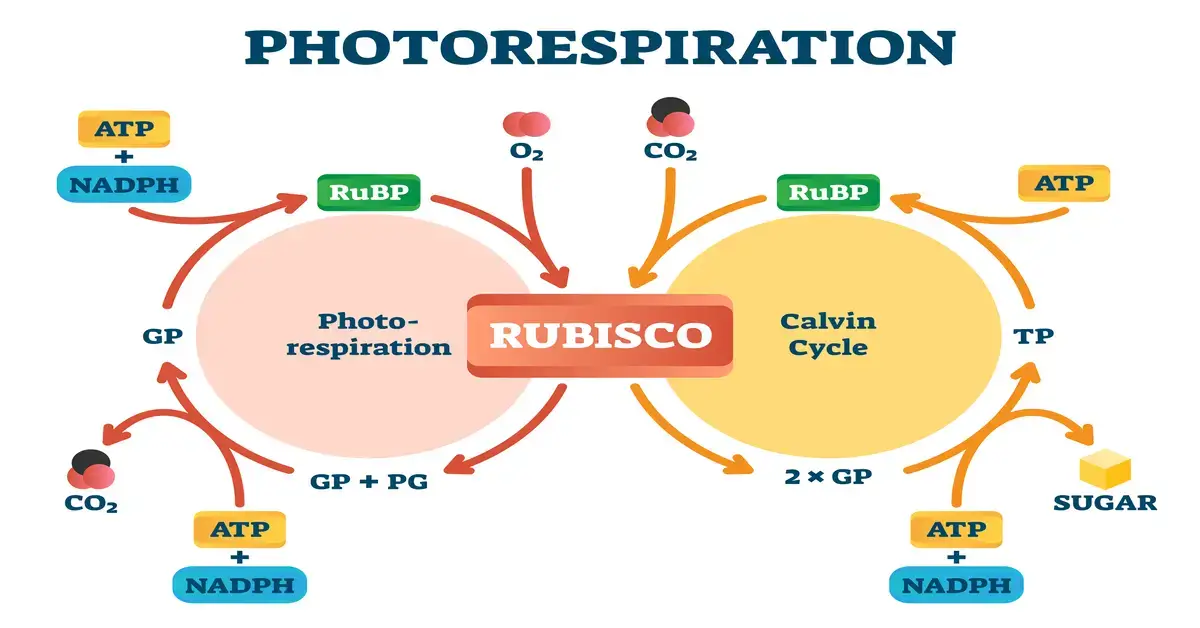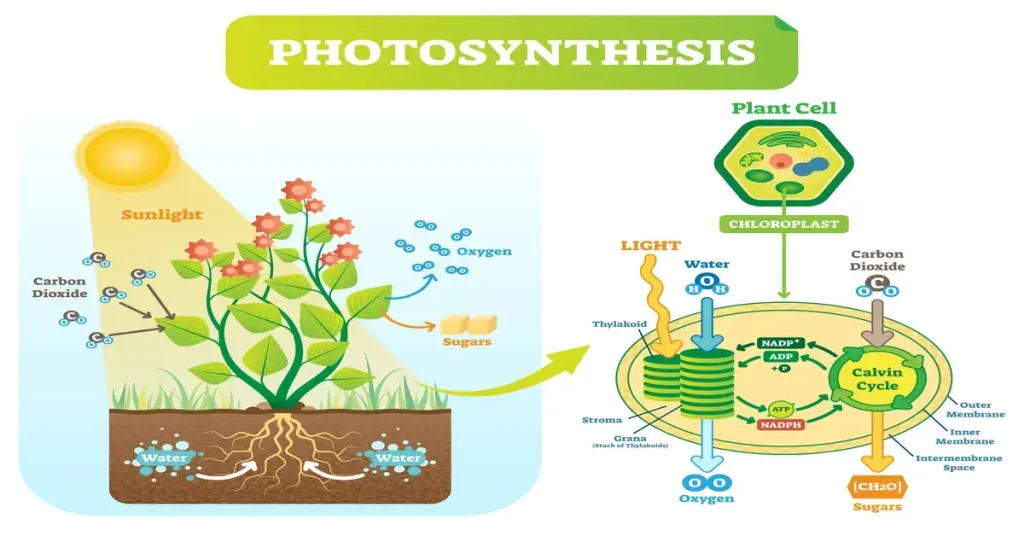Photosynthesis is the process that powers life on Earth, enabling plants to convert light energy from the sun into chemical energy. Through the synergy of chloroplasts and chlorophyll within plant cells, this remarkable process uses carbon dioxide and water to synthesize glucose—a vital molecule for growth and energy storage. As a byproduct, oxygen is released, providing the breath of life for countless organisms.
The Basics of Photosynthesis
Understanding the Essence of Photosynthesis
Photosynthesis is the biological process that enables plants, along with certain algae and bacteria, to absorb light energy and convert it into chemical energy. Within the chloroplasts of plant cells, carbon dioxide (CO2) and water (H2O) are transformed into glucose (C6H12O6), with oxygen (O2) being released as a crucial byproduct of this reaction.
The Photosynthesis Equation: Nature’s Alchemy
Encapsulated in a simple yet profound equation, 6CO2 + 6H2O + light energy → C6H12O6 + 6O2, photosynthesis maintains the delicate balance between reactants and products powered by solar energy. This equation represents the conversion of light energy into glucose. This carbohydrate serves as an energy reservoir for plants and, by extension, for the animals that consume them.
Chlorophyll and Chloroplasts: The Photosynthetic Powerhouses
Chlorophyll, the green pigment within the thylakoid membranes of chloroplasts, plays a pivotal role in capturing light energy. These organelles are the sites where light-dependent reactions occur, converting light energy into ATP and NADPH. These molecules then fuel the Calvin cycle, leading to the synthesis of glucose. This energy-rich carbohydrate sustains plant life.
To explore the wonders of photosynthesis up close, consider using a microscope kit like this one available on Amazon. It’s perfect for observing plant cells and their chloroplasts in action, offering an engaging hands-on way to learn about the microscopic world.
The Process Detailed
The Light-Dependent Reactions: Converting Sunlight to Chemical Currency
The journey from sunlight to chemical energy begins with light-dependent reactions. These occur within the chloroplast’s thylakoid membranes, where the chlorophyll pigment absorbs light, energizing electrons. These excited electrons travel through the thylakoid membrane in a process that ultimately generates ATP and NADPH, the plant’s energetic currency in the subsequent photosynthesis phases.
The Calvin Cycle: Synthesizing Glucose

After capturing the sun’s energy, the process enters the Calvin cycle, occurring in the stroma, the fluid-filled space of the chloroplasts. Here, ATP and NADPH from the light-dependent reactions are used to convert carbon dioxide into glucose. This series of reactions, known as carbon fixation, is how plants synthesize vital sugar molecules, fulfilling their energy requirements and supporting their growth.
Water and Carbon Dioxide: Essential Reactants
Water molecules are split in light-dependent reactions, yielding electrons, hydrogen ions, and oxygen, which are released as a vital byproduct. Carbon dioxide, absorbed by the plant, is the crucial ingredient in the Calvin cycle, where it is fixed into three-carbon molecules that are eventually converted into glucose. This transformation is essential, as glucose represents a primary energy source for the plant.
Oxygen and Glucose: Vital Byproducts
Photosynthesis generates oxygen and glucose, indispensable byproducts for life on Earth. Oxygen emerges during water splitting in the light-dependent reactions. At the same time, glucose, produced from carbon dioxide in the Calvin cycle, is a critical carbohydrate, providing energy and structural material for the plant. These compounds are crucial for plant life and the broader ecological system, sustaining a diverse array of life forms.
Photosynthesis in Action
Utilization of Glucose in Plant Metabolism
Once synthesized, glucose becomes a versatile molecule within the plant’s metabolism. It is used immediately for energy through respiration, allowing cells to perform their functions. Alternatively, glucose can be stored as starch or converted into cellulose to build and strengthen the plant’s cell walls. This sugar is a source of energy and a building block for growth, directly influencing the plant’s ability to thrive and reproduce.
Gas Exchange: The Role of Leaves and Stomata
With their broad surface area, leaves serve as the primary site of photosynthesis and gas exchange. Stomata, the microscopic openings on the undersides of leaves, regulate the passage of gases. They open to allow carbon dioxide to enter for photosynthesis and close to prevent excess water loss. Oxygen produced during photosynthesis exits through these same stomata, illustrating the leaf’s critical role in capturing light and facilitating the gas exchanges essential to this process.
Variations in Photosynthesis
Diverse Pathways in Photosynthetic Adaptation
Plants have evolved strategies to maximize photosynthesis efficiency, resulting in different types, namely C3, C4, and CAM photosynthesis. C3 photosynthesis, the most common pathway, involves the direct fixation of carbon dioxide into a three-carbon compound via the Calvin cycle.
C4 photosynthesis, on the other hand, efficiently fixes carbon dioxide in mesophyll cells, later releasing it to the Calvin cycle in a separate type of cell called bundle-sheath cells. This adaptation is particularly beneficial in high-temperature environments.
CAM (Crassulacean Acid Metabolism) plants have a different approach, opening their stomata at night to minimize water loss, a significant advantage in arid conditions.
Photorespiration: Overcoming a Photosynthetic Challenge

Photorespiration is when the enzyme Rubisco oxygenates RuBP, wasting energy and reducing the plant’s ability to fix carbon. C4 and CAM plants have developed mechanisms to minimize photorespiration, enhancing their survival in hot, dry climates. C4 plants segregate the initial steps of carbon fixation into different cells. In contrast, CAM plants temporally separate these steps, fixing carbon dioxide at night when temperatures are cooler and humidity is higher, reducing the likelihood of photorespiration.
The Global Impact of Photosynthesis
Oxygen Production and Atmospheric Balance
Photosynthesis is critical in maintaining the oxygen balance in Earth’s atmosphere. The oxygenic photosynthesis carried out by plants replenishes the oxygen that organisms consume during respiration. This continuous cycle is vital for sustaining aerobic life, highlighting the interconnectedness of all beings on the planet.
Sustaining the Biosphere and Food Chains
The energy captured and stored by photosynthesis is the primary source of nourishment at the base of almost all food chains. This energy transfer from plants to herbivores and carnivores is a fundamental ecological process. Additionally, photosynthesis contributes to the biomass that builds and sustains ecosystems, influencing everything from local water cycles to global climate patterns.
Agriculture and Food Security
Photosynthesis underpins agriculture by driving crop growth, directly impacting the global food supply. Enhancing the rate of photosynthesis through agricultural science has the potential to increase the yield of food crops, a critical consideration in the face of a growing world population. Understanding and optimizing photosynthetic efficiency in crops is crucial for food security and sustainable agricultural practices.
Frequently Asked Questions
Can plants perform photosynthesis without light?
While light is essential for the light reactions of photosynthesis, plants also engage in dark reactions (Calvin cycle), which do not require sunlight and can occur during the day or night. However, without light, the process would eventually halt as the necessary ATP and NADPH would deplete.
Do all parts of a plant contribute to photosynthesis?
Photosynthesis primarily takes place in the green parts of a plant, where chlorophyll is present. While leaves are the primary site of photosynthesis, other green parts, such as young stems and green branches, can also contribute to capturing light energy.
Is photosynthesis the same in all plants?
No, there are different types of photosynthesis, such as C3, C4, and CAM, each adapted to specific environmental conditions. These variations allow plants to optimize the process according to factors like light intensity, temperature, and water availability.
Debunking Myths About Photosynthesis
Myth: Plants only need sunlight to grow.
Reality: Plants require sunlight, carbon dioxide, and water for photosynthesis. Nutrients and minerals from the soil are also crucial for overall growth and development.
Myth: Photosynthesis is only about oxygen production.
Reality: While oxygen release is a critical aspect of photosynthesis, the process also creates organic compounds essential for the plant’s growth and energy needs.
The Educational Value of Photosynthesis
Understanding photosynthesis is a fundamental aspect of biology that informs many other scientific concepts, from cellular biology to ecological systems. Teaching photosynthesis equips students with knowledge about the vital processes that sustain life and the importance of plants in our ecosystem. It also underscores the need for environmental stewardship and conservation efforts to protect the photosynthetic organisms supporting Earth’s life.

